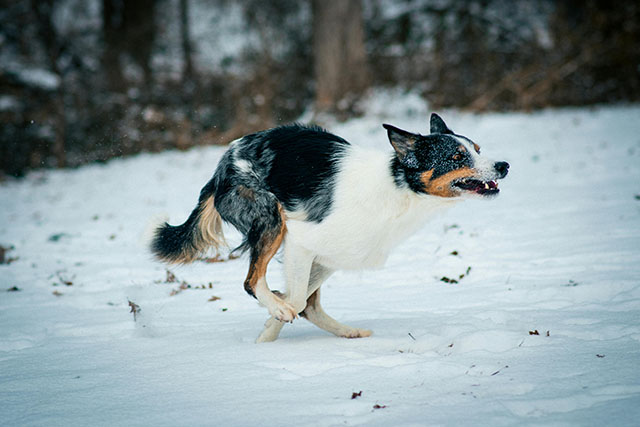Dog Rapid Breathing While Resting: Causes and Solutions
Have you ever noticed your dog breathing rapidly while resting? This can be a cause of concern for pet owners, as it may indicate an underlying health issue. As dog owners, we want to ensure that our furry friends are healthy and happy at all times.
Learn the potential causes of rapid breathing in dogs while resting and provide some solutions to help alleviate this issue.
Why is My Dog Lying Down but Breathing Fast?
When your dog is lying down but breathing fast, it can be alarming. It’s essential to understand that several factors might contribute to this condition, ranging from benign to serious. Here are the main reasons:
Heatstroke or Overheating
Dogs can easily get overheated, especially during hot weather or after intense exercise. This can lead to rapid breathing as their body attempts to cool down.
Stress or Anxiety
Just like humans, dogs can experience stress and anxiety, which may manifest in physical symptoms such as rapid breathing. This could be caused by loud noises, changes in the home, or separation anxiety.
Pain or Discomfort
If your dog is in pain, they might breathe rapidly. This pain could be due to injuries, arthritis, or internal issues.
Respiratory Disorders
Conditions like pneumonia, bronchitis, or even allergies can cause difficulty breathing, leading to an increased respiratory rate.
Heart Disease
Dogs with heart problems may exhibit rapid breathing due to their heart’s inability to pump blood efficiently.
Anemia
A reduced level of red blood cells can lead to anemia, making it harder for your dog to get enough oxygen, resulting in faster breathing.
Ingestion of Toxic Substances
If your dog has ingested toxic substances, rapid breathing can be a symptom of poisoning.
Infection or Illness
Various infections and illnesses, especially those affecting the lungs or airway, can cause rapid breathing in dogs.
Understanding the root cause of your dog’s rapid breathing while lying down is critical. If this condition persists or is accompanied by other worrying symptoms, it’s important to consult a vet for a thorough evaluation and appropriate treatment.
What are the Signs of Heart Failure in Dogs?
Heart failure in dogs can manifest through several symptoms besides rapid breathing. Recognizing these signs early can be vital for the timely treatment and management of the condition. Here are key indicators of heart failure in dogs:
- Persistent coughing, especially at night or early in the morning, can be a sign of fluid accumulation in the lungs due to heart failure.
- Reduced Exercise Tolerance: Dogs with heart conditions may become easily tired and may not be as enthusiastic about walks or play as they used to be.
- Fainting or Collapse: Episodes where your dog may faint or collapse are severe signs and require immediate veterinary attention.
- Abdominal Swelling: Accumulation of fluid in the abdomen, known as ascites, can cause noticeable swelling and discomfort.
- Weight Loss or Anorexia: Dogs experiencing heart failure might lose weight or show less interest in food.
- Behavioral Changes: Look for changes in behavior, such as increased restlessness or isolation seeking, which might indicate discomfort or pain.
- Difficulty Breathing: Apart from rapid breathing, you may notice your dog trying hard to breathe or changes in the breathing pattern.
If you observe any of these symptoms in your dog, along with rapid breathing while at rest, it’s crucial to consult with a veterinarian as soon as possible. Early diagnosis and intervention can significantly improve the quality of life for dogs with heart failure.
When Should I Worry About Rapid Breathing in My Dog?
It’s natural to worry about your dog, especially when something as vital as their breathing seems off. While rapid breathing can occur for benign reasons, certain scenarios necessitate immediate concern and action. Here are situations that represent the worst-case scenario and should prompt you to seek veterinary care without delay:
- Persistency: If the rapid breathing is persistent and doesn’t return to normal after a short period of rest or relaxation.
- Distress Signals: Your dog is showing signs of distress, such as whining, pacing, or an inability to settle down, alongside rapid breathing.
- Physical Discomfort or Pain: If there are signs of physical discomfort (e.g., limping, reluctance to move) or vocalizing pain when you touch them.
- Additional Symptoms: Accompanying symptoms such as coughing, fainting, or blueness in the gums indicate severe issues.
- Behavior Changes: Any sudden or severe change in behavior along with rapid breathing, like aggression or extreme lethargy, can signal a serious condition.
- Post-Exercise: If your dog’s breathing doesn’t slow down long after exercise or exposure to heat, suggesting an inability to recover normally.
- History of Illness: Dogs with a history of respiratory or heart issues that suddenly start breathing rapidly might be experiencing a worsening of their condition.
In these instances, the rapid breathing could be symptomatic of life-threatening conditions such as heart failure, severe infections, or poisoning. Immediate veterinary consultation is imperative to diagnose and address the underlying cause of the rapid breathing.
What Position Helps a Dog Breathe Better?
When dogs battle respiratory issues that lead to rapid breathing, positioning them correctly can sometimes provide significant relief. Here are some tips to help your dog breathe more comfortably:
- Stabilizing Position: Encourage your dog to lie down in a ‘sternal’ position, meaning they rest on their belly with their legs outstretched. This position helps in expanding their lungs more fully and eases breathing.
- Elevating the Head and Chest: Slightly elevating your dog’s head and chest can also assist in easing breathing. Use a pillow or a folded towel under their chest and head to create a gentle slope. This can help in the case of congestive heart failure or other respiratory issues where fluid might be a concern.
- Ensuring a Cool Environment: Make sure your dog is in a cool, well-ventilated space, especially if overheating is a concern. A room with air conditioning or a fan can help prevent overheating and facilitate better breathing.
- Limiting Movement: During episodes of rapid breathing, minimize your dog’s physical activity to help reduce their oxygen demand. Gently guide them to a comfortable resting spot where they can relax without the need for excessive movement.
- Avoiding Restrictive Collars: Ensure that nothing is constricting your dog’s neck or chest, such as a tight collar, which could further impair breathing. Opt for a harness instead, especially if your dog needs to be led outside for bathroom breaks.
Implementing these positions and considerations can create conditions that facilitate easier breathing for dogs experiencing respiratory distress, providing them with relief and potentially preventing the situation from worsening while you seek veterinary care.
How Can I Calm My Dog’s Breathing?
If your dog is experiencing rapid breathing due to anxiety, stress, or overheating, there are several steps you can take to help calm them down and normalize their breathing rate. Follow these steps to provide comfort and aid:- Create a Quiet Environment: Move your dog to a quiet, familiar space away from loud noises or stressful situations. A serene setting and a comfortable space like Bedsure Dog Bed can help reduce their anxiety levels.
- Offer Water: Ensure they have access to fresh, cool water. Consider using Amazon Basics Gravity Pet Waterer, because dehydration can exacerbate rapid breathing, so it’s important to keep them hydrated.
- Use a Calming Voice: Speak to your dog in a calm, soothing tone. Your voice can be a powerful tool in reassuring them and helping to lower their anxiety.
- Gentle Petting: Soft, gentle strokes along their back or head can be comforting. Avoid overly vigorous petting which might excite them further.
- Cooling Down: If overheating is a concern, help cool your dog down by providing a fan, such as Treva 5-inch Pet Crate Fan, moving them to an air-conditioned room, or using cool (not cold) wet towels on their paws and around their head.
- Limit Physical Activity: Encourage your dog to stay in a resting position rather than moving around too much, which can increase their breathing rate.
- Practice Deep Breathing: Although it might sound odd, demonstrating deep breaths yourself can sometimes influence your dog to mimic your breathing. Dogs are very attuned to our behaviors and can pick up on cues for relaxation.
- Use Calming Aids: Consider using pet-safe calming aids like a pheromone diffuser, calming chews, or a weighted anxiety blanket designed for dogs, if their stress levels frequently impact their breathing.
- Consult a Veterinarian: If rapid breathing episodes are frequent and not solely linked to immediate stressors or heat, seek advice from a veterinarian. They can provide specific recommendations or treatments for underlying conditions.
Keeping Your Furry Friend Breathing Easy
Rapid breathing in dogs can stem from a range of causes, both benign and serious. Being observant of your dog’s normal breathing patterns and aware of the signs that indicate distress or underlying health issues is crucial. Implementing the comfort and care strategies outlined can significantly help in managing situations of rapid breathing due to stress, heat, or minor health issues. However, it’s imperative to prioritize professional veterinary care when symptoms persist or when the underlying cause of rapid breathing is unclear. By staying informed and proactive, you can ensure the wellbeing of your furry companion, keeping them healthy, happy, and breathing easy.Jessica is a veterinary medicine student who is passionate about animals. Living with her cherished dog, Milo, deepens her understanding of the human-animal connection, enhancing her empathy as a future veterinarian.
Jessica’s concise articles reflect her dedication to improving the lives of animals and those who care for them, making her an inspiring figure in the pet care field.







